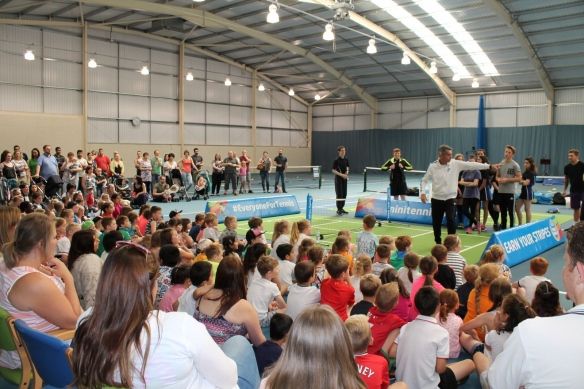The team behind Greenwich Leisure Ltd, a not-for-profit company thinks it has a business model that can deliver tennis to a wide audience while remaining financially viable.
“We consider ourselves the Robin Hood of leisure operators,” says Barry Cawte, National Tennis Manager at GLL, which is fast becoming the biggest operator of public tennis facilities after snapping up a range of venues in the past 12 months.
Two years ago, GLL operated just one indoor tennis venue, Islington Tennis Centre in north London. In the last 12 months its tennis offering has grown to eight indoor centres, including high-performance centres Gosling Sports Park and its most recent acquisition, Sutton Sports Village.
Launched in 1993, Greenwich Leisure Ltd is the UK’s largest not-for-profit charitable social enterprise, and works with councils and other partners to run sports and leisure centres, libraries and children’s centres under its consumer brand, Better.
“There are no barriers to participation,” explains GLL National Tennis Coach Nick Elliot, who was working as director of tennis at the White Horse Leisure and Tennis Centre in Oxfordshire when GLL acquired the venue two years ago. “Every one of our centres you can walk in and play tennis. You could play here once a year if you wanted to.”
Tennis has swiftly become a core part of GLL’s business and working in close partnership with the LTA and the Tennis Foundation, GLL is the largest provider of LTA products such as Tennis Tuesdays and the Great British Tennis Weekends. Its tennis business already turns over £2 million a year, a figure which is expected to double inside 12 months following the acquisition of Gosling and Sutton.
Similarly, while participation figures have already increased from 900 taking part in regular tennis lessons in 2014 to 2,500 in 2016, those numbers are anticipated to double before the end of 2017.
The secret? Simple economics. With more than 10,000 staff across all its facilities, and a dedicated national tennis team, GLL’s strength is in its sheer size.
“If you’re a local authority running a tennis centre it almost becomes a liability – the running costs are so expensive and the effort you’ve got to put in to run an indoor tennis centre is astronomical,” explains Cawte. “But we’ve strength in numbers.
Some centres we have taken over will take a lot of work to turn them around, but if we’ve got centres like Gosling, or Sutton, or White Horse [Tennis Centre in Oxfordshire] then we can use the good ones to prop up the poor ones until we can get them all working to the level we would like.”
Cawte is well positioned to drive GLL’s tennis crusade. Having joined a social enterprise in 2011 to save Swansea Tennis Centre following severe budget cuts in leisure by Swansea Council, he turned the former council-run facility into a financially sustainable leading indoor community venue. He went on to work as a consultant for the LTA and Tennis Foundation to improve a number of indoor facilities in the UK before joining GLL in March 2015.
“It’s not rocket science,” says Cawte, whose role at GLL is part-funded by the Tennis Foundation. “We found a model that allows tennis to be sustainable in our venues, and that’s just bums on seats. There are two common types of models – high cost-low volume and high volume-low cost. We would rather have hundreds of people playing than ten people paying £1000 a year.”
While the Better leisure centres and tennis facilities offer membership options, its success is in its pay and play model.
“A lot of the tennis centres we took over were like tennis clubs with a membership fee, something like £40 a month,” explains Cawte. “That may sound like a great deal for a really passionate tennis player but all it does is give that person the opportunity to book as many courts as they want and before you know it all your courts are gone and you haven’t got any kids playing on there.
“If you’ve got an indoor centre with four tennis courts and you’ve got the same 50 people block-booking them, that’s not great for business, it’s not great for participation and it’s not great for tennis.
“Our ethos is about growing the tennis programmes and making sure we have as many Mini Reds, Mini Oranges and Mini Greens as possible. It’s common sense: you’ve got one tennis court and you can have four people on there playing doubles or you can have 30 kids on there doing Mini Reds. Then two things happen: financially you become more sustainable with 30 kids and secondly you get higher numbers of people playing tennis.”
Cawte uses the “100” number as a benchmark: getting 100 people into lessons and courses per court. “If you have four indoor courts and 400 people on your programme you’re more likely to run a sustainable tennis centre,” he explains. He is careful to use the word sustainable rather than profitable – as a charity GLL reinvests any profits back into the facilities and communities it works in.
Sustainability is the buzzword for GLL in tennis. It might be a relatively new kid on the block when it comes to the UK tennis scene, but it has long-term vision.
“I need to get more people playing tennis,” says Cawte, “but I need to make sure we are running sustainable tennis programmes because if we don’t the court gets knocked down and a gym or a 3G football pitch gets built in its place.
“We have to make sure we have a sustainable tennis programme that will be there in five years’ time, 10 years’ time, even 100 years’ time. We’ve just purchased Sutton and we’re in a long-term agreement with Gosling so we’re in tennis for the long run. We’ve got to make it work and we believe we can.”
